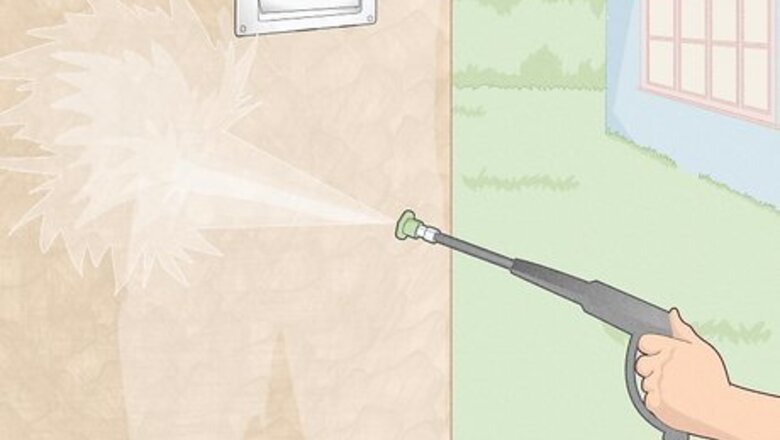
views
- First, remove dirt and grime from your stucco with a bristle brush and a pressure washer. Ensure the surface is completely dry before priming or painting.
- For small patches of stucco, cut your trims with a paintbrush and apply acrylic primer and paint with a 1-inch (2.5 cm) nap roller using angled, upward strokes.
- Or, use a paint sprayer for large walls or two-story homes. Choose a wide nozzle sprayer and backroll the paint with a roller to mimic the textured pattern of stucco.
Pressure wash your exterior stucco.
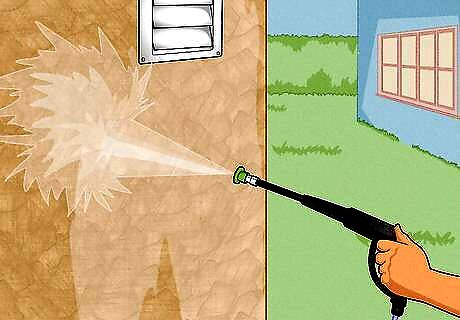
Use a low-pressure spray to remove dirt and help your paint stick. To clean your exterior stucco walls, apply a layer of pressure washing detergent, allowing it to sit for 10 minutes. Then, set a pressure washer to low-pressure mode (1,500–2,5000 PSI). Hold the spray nozzle at least 24 in (61 cm) away to avoid damaging the surface. Start rinsing from the top and work your way down so the soapy dirt will flow downward. Clean one section at a time, overlapping slightly to avoid missing any spots. Before using a pressure washer, manually remove obvious dirt or debris within reach with a bristle brush. Don’t allow the detergent to dry. You may need to add fresh detergent as needed. Some home improvement stores offer rentals if you can’t purchase a pressure washer. If you do not have any cracks to repair, allow the surface to dry for 3 to 4 days before proceeding with paint.
Repair minor cracks in the stucco.
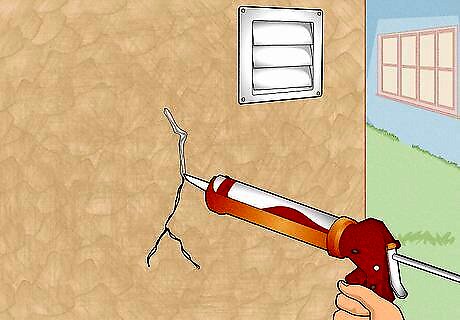
Use masonry caulk to fill in cracks smaller than ⁄16 in (0.16 cm). Insert a tube of masonry caulk into your caulk gun and clip the tip off with scissors. Apply a bead of masonry caulk over the crack and smooth it with a gloved finger, applying even pressure. Wait at least 24 hours before doing anything else. For larger cracks, chip away loose material with a putty knife. Then, mix stucco patching compound with water to form a thick paste. Rub the compound into the gap. You may need to drag your putty knife back and forth in random directions to replicate the texture of the stucco. Add and spread more compound until it matches the wall around it. Wait 7 to 10 days before painting. It’s natural for a crack or two to develop over time, but if you’ve got dozens of cracks to fill, or if the cracks are very large, it may be time to replace your stucco.
Choose a breathable paint.
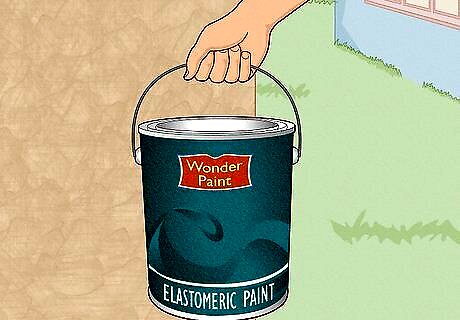
Choose acrylic, masonry, or elastomeric paint for exterior stucco walls. Stucco tends to absorb and store moisture, so when choosing paint, opt for ones that offer breathability (or have a high permeability value). Exterior acrylic paints are the most common option for stucco. However, elastomeric paint can bridge small cracks if cracking is an issue. Similarly, masonry paints are made specifically for stucco walls and have a greater bond and mildew resistance than other paints. Use flat acrylic if you want the stucco’s texture to stand out or satin acrylic to give the surface a bit of shine. If you have stucco indoors, you can use interior acrylic. Unless you installed the stucco yourself, it’s doubtful that the indoor textured wall is actually stucco. The odds are much higher that it’s drywall compound.
Prime the stucco.
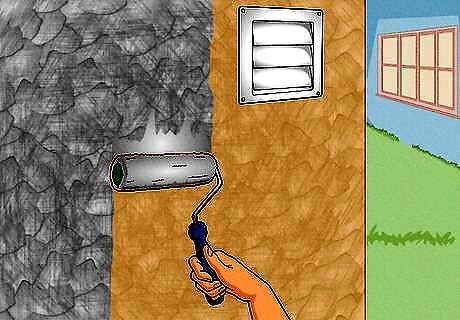
Apply high-quality acrylic masonry primer with a large-napped roller. Use a large synthetic brush to cut the edges of your stucco in a thick layer of primer. Then, use a large-napped roller to coat the wall, working in vertical strokes. Cover each layer multiple times, dragging the roller slowly to ensure you cover every nook and cranny of the stucco. Let the primer dry for as long as the instructions recommend on the container. 1-inch nap rollers are best for coarse or textured surfaces, like stucco. It may help to get an extension rod for your roller if part of your stucco extends up to a second floor. If the stucco surrounds any windows, doors, gutters, or porches, tape off any areas you want to keep dry and lay down a drop cloth before you get to work.
Paint small stucco surfaces with a roller.
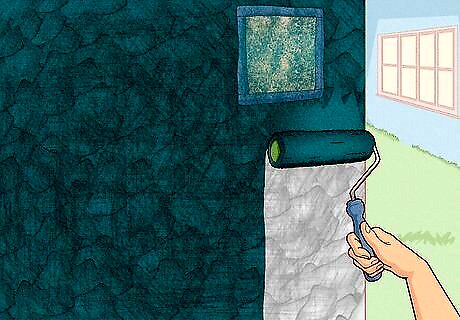
Roll 100% exterior acrylic paint for 1-story homes or small patches. Using a roller is easiest if you’re working on a smaller surface. Start by painting the trims with a synthetic brush. Then, pour the acrylic paint into a tray or 5-gallon bucket. To use a paint roller, roll the nap back and forth in the tray 5 or 6 times to fully saturate it. Roll the paint onto the wall using a slightly angled, upward stroke. It may take 2 coats to fully cover the surface and achieve a uniform look. Wait at least 24 hours between coats.
Use a paint sprayer for large stucco surfaces.
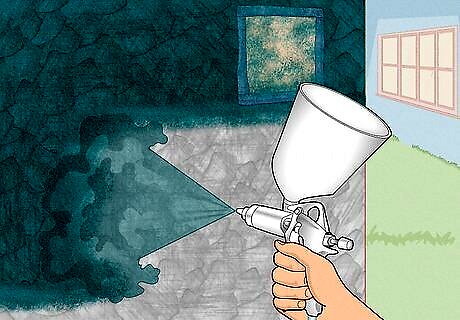
Choose a wide-nozzle sprayer and backroll the paint with a roller. Spray each wall using long, vertical strokes. Once you’ve covered a roughly 10 by 10 feet (3.0 by 3.0 m) section with your sprayer, set it down and grab a thick-nap roller. Roll over the section you’ve just painted to smooth the paint out and spread it around. Keep working like this until you’ve covered the entire wall in paint. Cover each area you’ve painted with a second coat of random strokes after you backroll it to mimic the different angles in the stucco texture. This will fill any minor spots you missed. You can cut the trim with a synthetic brush if you’d like, or lay down a drop cloth on the floor and hold flat lengths of cardboard against edges you want to keep dry while you paint. You can rent a paint sprayer for your local home improvement store.
Apply a second coat of paint if needed.

Let the paint dry for at least 24 hours before applying another coat. Generally, stucco will require two coats of paint because of its high absorption level and bumpy texture. Refer to the instructions on your can of paint before proceeding. Follow the same steps from before until the job is complete. Painting stucco is a good idea if you live in a hot, dry area. If you live in an area with frequent rain, wait for a dry day. Stucco tends to break down the more it absorbs water, affecting the paint quality.




















Comments
0 comment